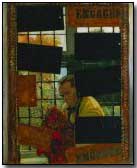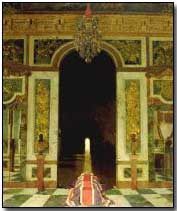Who's Who - Sir William Orpen
 Sir William Orpen (1878-1931) served as
an official British war artist during the First World War, and painted
portraits of numerous senior military and political figures.
Sir William Orpen (1878-1931) served as
an official British war artist during the First World War, and painted
portraits of numerous senior military and political figures.
Orpen was born at Stillorgan on 27 November 1878 the son of a Dublin solicitor. Something of an infant prodigy Orpen was accepted into Dublin's School of Art when aged just eleven. Six years later he entered Slade School of Fine Art where he studied under Henry Tonks.
Having been recommended by John Singer Sargent Orpen achieved rapid initial success and established for himself a reputation as a portrait artist. In 1910 he was elected ARA.
With the arrival of war in 1914 Orpen's role was initially limited to the auctioning of blank canvases upon which the purchaser's portrait would be later painted, funds raised going to the Red Cross.
Towards the close of 1915 however Orpen felt obliged to take a more active role in the prosecution of the war effort. With the assistance (and influence) of the British Army Quartermaster-General, Sir John Cowans - whose portrait Orpen was currently preparing - Orpen secured a commission into the Army Service Corps.
Initially tasked with routine office work at Kensington Barracks he came to the attention of Charles Masterman, responsible for the War Propaganda Bureau, at the end of 1916. Masterman recruited Orpen as a war artist, where he was joined by others including Paul Nash, Muirhead Bone and Wyndham Lewis.
Cowans further assisted Orpen by arranging for him to be promoted to Major and despatched to France, where it was anticipated that Orpen would paint portraits of a number of senior military command figures. Cowans (doubtless correctly) believed that Orpen would be regarded more seriously if he held a higher military rank.
 Thus
throughout 1917 and 1918 Orpen was responsible for portraits of generals,
privates and politicians, including
Sir Douglas Haig,
Hugh Trenchard and
Herbert Plumer.
Other notable paintings included Dead Germans in a Trench, Members
of the Allied Press Corps and Ready to Start.
Thus
throughout 1917 and 1918 Orpen was responsible for portraits of generals,
privates and politicians, including
Sir Douglas Haig,
Hugh Trenchard and
Herbert Plumer.
Other notable paintings included Dead Germans in a Trench, Members
of the Allied Press Corps and Ready to Start.
Following the armistice Orpen was appointed the official portrait artist at the Paris Peace Conference and was responsible for the The Signing of the Peace.
However he courted controversy when, in To the Unknown British Soldier in France, he painted a coffin flanked by winged putti and two wraith-like figures from the trench set against the splendid backdrop of the Paris Peace Conference. This comprised Orpen's protest at the conduct of the political elite in Paris at the expense of the efforts of the common soldier in the trenches.
Unsurprisingly Orpen's painting provoked a storm of criticism. Before it could be hung at the Royal Academy (and it was only belatedly accepted by the Imperial War Museum in London) Orpen was required to paint out the image of the dead soldiers.
Following the war Orpen was elected RA in 1919 and returned to portrait painting, which included one of the British wartime Prime Minister David Lloyd-George in 1926.
Having completed some 600 portraits, and published his wartime memoirs as An Onlooker in France, Orpen died in 1931 aged 53.
The "Blue Max" was a reference to the prestigious German Pour le Merite medal.
- Did you know?
